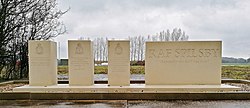Old All Saints Church, Great Steeping
Church of England church buildings in LincolnshireChurches completed in 1748Churches completed in 1908Churches preserved by the Churches Conservation TrustFormer Church of England church buildings ... and 2 more
Georgian architecture in EnglandGrade II* listed churches in Lincolnshire

Old All Saints Church is a redundant Anglican church in the village of Great Steeping, Lincolnshire, England. It is recorded in the National Heritage List for England as a designated Grade II* listed building, and is under the care of the Churches Conservation Trust. The church stands in marshland, surrounded by a medieval field system, at the end of a lane leading south from the B1195 road, some 3 miles (5 km) southeast of Spilsby.
Excerpt from the Wikipedia article Old All Saints Church, Great Steeping (License: CC BY-SA 3.0, Authors, Images).Old All Saints Church, Great Steeping
Old Church Lane, East Lindsey Great Steeping
Geographical coordinates (GPS) Address Nearby Places Show on map
Geographical coordinates (GPS)
| Latitude | Longitude |
|---|---|
| N 53.1533 ° | E 0.1441 ° |
Address
Old Church Lane
PE23 5PR East Lindsey, Great Steeping
England, United Kingdom
Open on Google Maps










